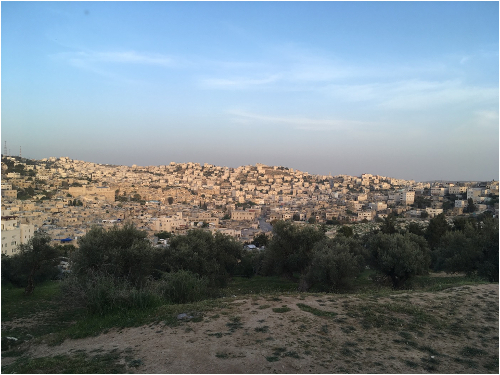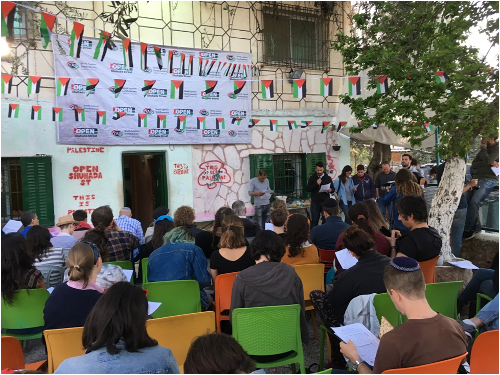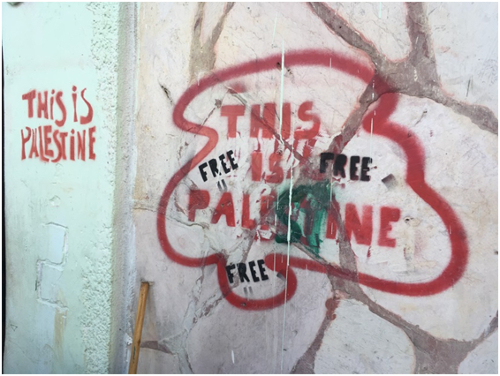On Wednesday, April 4th during the week of the Jewish holiday of Passover, Youth Against Settlements (YAS) [ http://hyas.ps ] – a nonviolent direct-action group that works to oppose the expansion of Jewish settlements in Hebron – and All That’s Left (ATL) [ https://allthatsleftcollective.com/about/ ] – a Jewish collective based in Israel and ‘unequivocally opposed to the occupation and committed to the diaspora angle of resistance’ – together hosted a ‘freedom seder’ in the Tel Rumeida neighborhood of Hebron. Modeled after the historic freedom seder of 1969 led by Rabbi Arthur Waskow, the year after Dr. Martin Luther King's assassination, this freedom seder in Hebron commemorated 50 years since the Jewish settlers in the occupied city began the process of dispossession of Palestinian homes and neighborhoods. A diverse group of over one hundred local and international Jews and non-Jews, many of whom had heard of the seder through Facebook and word of mouth, attended in order to stand in solidarity with YAS, gain greater insight into the realities of Hebron, and celebrate a commitment to freedom from oppression inherent in the Passover Exodus story.
Bitterness and Celebration: The Seder Itself

View of Hebron from Sodom Center patio (Photo: Grace Hack)
Upon arrival to the Sodom Center, the home-base of YAS and the site of the evening’s seder, participants saw one of the most beautiful views overlooking the city and the mountains. The center’s patio was set with colorful chairs and the trees were strung with Palestinian flags. Delicious smells wafted from the kitchen promising a fantastic dinner. Hagaddah inserts translated into English, Hebrew, and Arabic were passed around, as well as informational pamphlets on Hebron and pieces of matzah.
The seder began with opening remarks from Daniel Roth of ATL, Izzat Karake of YAS, and former speaker of the Knesset Avraham Burg. Roth explained the seder’s concept and the importance of weaving together the ancient Jewish story of liberation with contemporary Palestinian struggles for freedom. Izzat Karake introduced the YAS team and affirmed the need for the kind of non-violent resistance YAS does citing ‘there are enough victims.’ Burg told the story of how his mother and her family, pre-state Jewish Hebronites, were saved by their Palestinian neighbors during the riots of 1929. Though contemporary settlers see this massacre as justification for their settlement, Burg challenged that narrative, attesting that the riots were not an ‘excuse for all the abuses.’ Of the Palestinian family who saved his mother’s life, Burg avowed, ‘I owe my life to them’ and finished his speech calling for us all to resist forces that repress the will for peace.
And then the seder began. A series of nine readings thematically following the steps of the traditional Jewish Passover seder were read aloud by ATL and YAS activists in Arabic, English, and Hebrew. ‘Seder,’ the insert read, ‘means “order” or “agenda”’ and that night the agenda was clear: ‘we stand together here and now to reaffirm the commitment to liberation in every generation and for all peoples.’ This opening was followed by re-interpretations of the four questions and the four children among various readings and concluded with poems The Butterfly’s Burden by Mahmoud Darwish as well as The Art of Blessing the Day by Marge Piercy. The entire Haggadah insert was made available online [ https://allthatsleftcollective.com/2018/03/18/a-freedom-seder-in-hebron/ ] so that even those not in attendance could include this act of solidarity in their own family celebrations.

YAS and ATL activists lead the seder in Arabic, English and Hebrew (Photo: Grace Hack)
Hearing powerful words spoken in multiple languages by people – Palestinian, Israeli, and diasporic – who truly have devoted their lives to the pursuit of justice and peace in this land was deeply inspiring. The seder itself centered, not on the specific abuses of the Israeli state and the daily slog of incremental change, but on the future of global liberation we all hope for. In many ways it was a gift, a moment of pause in a reality of deep violence and turmoil, to feel grateful for the freedoms we have and renew the commitment to fighting for the ones that we and our fellows still lack. In true Passover tradition, we mixed the world’s bitterness with celebration, community and the breaking of bed. Our freedom Haggadah itself said: ‘Most nights we don’t sit at ease at dinner. Tonight, we rest for a moment, in celebration that we are here together.’ And as the seder concluded, Karake echoed this saying, ‘eat well and tomorrow we end the occupation!’
YAS and the Violence of Occupied Hebron
The seder was followed by dinner and schmoozing. As a participant, I took this opportunity to talk to members of YAS and gain greater insight into the conditions in H2, the 20% of Hebron that contains Jewish settlements and has therefore been brought under Israeli control. Because Israeli policies use the ‘principle of separation’ to protect settlers in occupied territories, the small population of Jewish settlement in Hebron – around 700 Jewish settlers in a city of 200,000 – has resulted in a system of checkpoints, curfews, and road closures that physically and legally segregate and protect Jewish freedom of movement at the expense of Palestinian. Only proven Palestinian residents of H2 are allowed in through one of the 20 permanently staffed checkpoints, and YAS members spoke bitterly of the ‘number’ that designates their identity and right to pass. Even with a residency number, Palestinians are liable to be detained, questioned, and humiliated at checkpoints for any length of time, and are often arrested or killed extra-judicially. One YAS member told me that he had been arrested five times in six years, most recently for ‘carrying a knife’ that was moments earlier dropped at his feet by an Israeli soldier. Even though he was beaten and detained for hours, he said he feels lucky to be alive, as many other young Palestinians in his community have been killed for seeming suspect. What outraged me most hearing this man talk was that the soldiers stationed in H2 know him and the non-violent activism he does for YAS. They may have even accepted a cup of coffee from him during a shift outside the center yet, through expectations set by commanders and IDF policies do not spare him from unnecessary violence. Perhaps it makes sense then that the IDF and the Israeli civil police rarely intervene when Palestinians are subject to harassment at the hands of settlers. The Israeli human rights organization B’tselem (https://www.btselem.org/hebron) cites ‘beatings, throwing stones or garbage, poisoning water wells, [attempting] to run over people with cars, and gunfire’ as well as the destruction of Palestinian property and agriculture as common to settler abuse. YAS members attested that this climate of violence causes many Palestinian parents to keep their children home from school in fear for their safety.
All this has turned Hebron into a ghost town, gutting the city’s economic, cultural, and religious life. The closure of Shuhada street after the Baruch Goldstein massacre in the Ibrahimi Mosque [ https://www.aljazeera.com/news/2016/02/remembering-ibrahimi-mosque-massacre-160225061709582.html ] has meant the end of many businesses, the welding shut of Palestinian residences facing the street, and the suppression of the entire city’s formerly-vibrant center. Adding insult to injury, street signs previously in Arabic are now entirely in Hebrew and in English. Izzat Karake of YAS, who addressed the group again after dinner, explained that the ultimate result of these occupying measures is not just that Palestinian lives in H2 are made unbearable, but that the very Palestinian identity of Hebron is being wiped away, an even greater cruelty. Said Karake, ‘it means a lot for us as Palestinians…it means we do not exist.’
What brightens these growing injustices is YAS and the work they do on a number of fronts to counter the expansion of settlements through non-violent civil resistance. In the Sodom Center, YAS members train and educate the youth and adults who encourage Palestinian residents of H2 to stay in their homes by providing volunteer home services and repair that would otherwise be denied by checkpoint policies. YAS, partnered with B’tselem, engages in human rights documenting and activism and the center provides classes in photography, video editing, and social media as well as English and Hebrew instruction. They also provide trainings in legal issues and educate Palestinians about the rights they can demand from the Israeli state. YAS maintains a neighborhood kindergarten so that children do not have to pass through checkpoints on their way to school and yearly launches the global Open Shuhada Street campaign to restore it as the cultural and commercial center of Palestinian life. YAS members engage in international advocacy and tell their stories abroad to gain the support and recognition that is, for better or for worse, essential to their work. As Karake admits, the reality of Palestinian activism is that ‘if we were not famous, we would not have you here.’
The seder was a great success. Many new allies have added their voice to condemning the injustices in Hebron and spreading the word about the work YAS does. ATL may have even found new members ready and inspired to plan events such as this one in the future, or even better, organize anti-occupation efforts in their own communities. All who had the privilege to attend will be spurred forward by the seder’s refrain: ‘Injustice anywhere is a threat to justice everywhere.’ – Dr. Martin Luther King Jr.

A message on the Sodom Center Wall (Photo: Grace Hack)
